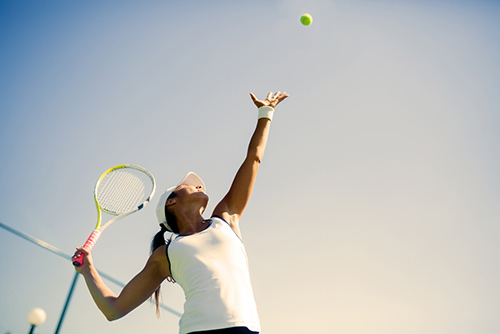
Now that spring is officially here and nice weather is in the forecast, there’s a whole new set of sports to get excited about! However, with these new activities comes the possibility of injuries. While it’s important to prepare for the season ahead, some injuries are just inevitable. In this blog, we’ll discuss some of the most common injuries for spring sports and how to prevent them.
Baseball and Softball
When playing baseball or softball, athletes are expected to do it all — swing, catch, throw, run, jump, and slide. With all of this movement, plus hours of game time/practicing in the heat, it’s bound to lead to an injury. Overuse injuries are frequently seen in pitchers who repeatedly do the same throwing motions for long periods of time. This is likely to lead to issues in the shoulder or elbow. It’s important that pitchers don’t throw too much or too hard. Traumatic injuries are likely to happen when getting hit with a ball or during a fall or collision on the field. Some common injuries associated with baseball and softball:
- Rotator cuff tendinitis/tear
- SLAP tear
- Biceps tendinopathy
- Medial elbow apophysitis
- Ulnar collateral ligament injury
- Cuts and bruises
Golf
Golf is often thought of as an easy and relaxing sport, but think again! If you’re an avid golfer, you’ve probably suffered from at least one of these injuries either due to a lack of technique or overuse. The three most common injured areas in golfers are the back, shoulder, and elbow. The sport requires long hours of being hunched over your clubs, with forceful but repetitive swings, which can put extra strain on your body. Some common injuries associated with golf:
- Lower back pain
- Golfer’s elbow (tennis elbow)
- Rotator cuff injury
- Torn meniscus
- Wrist tendinitis
Soccer
Soccer is one of the most widely played and watched sports in the world. Those who choose to play must understand the risk of injury that goes with the game. Due to the physical demands and fast-paced nature of the game, sprains, strains, fractures, and head injuries are very common. Typically, these injuries are a result of collisions, sudden jolting movements, as well as overuse. Some common injuries associated with soccer:
- Ankle sprain or strain
- Muscle-tendon injuries (quadriceps and hamstrings)
- Knee injuries (torn ACL or meniscus)
- Concussion
- Cuts and bruises
Tennis
Tennis is a very popular sport to be played at all ages and levels of ability. Whether you play competitively or recreationally, it’s not uncommon to suffer from an overuse injury. Those who play for fun may get injured due to inadequate technique and improper form. One of the most commonly treated injuries is named after this sport — tennis elbow, which is pain in the elbow and arm. Some common injuries associated with tennis:
- Tennis elbow
- Rotating cuff tendinitis/tear
- Stress fracture
- Patellar tendinitis
- Ankle sprain
- Achilles tendon rupture
Track and Field
It’s common for track and field athletes to push themselves to the limit. The repetitive motions of running, jumping, and throwing cause wear and tear on the muscles and joints, which takes a toll on the body. Even though it’s a non-contact sport, it can still lead to some painful injuries. Some common injuries associated with track and field:
- Patellar tendinitis
- Shin splints
- SLAP tear
- Hamstring sprain
- Rotator cuff injury
- Stress fracture
- Plantar fasciitis
- Ankle sprain
How to Prevent Sports Injuries
- Warm Up Consistently – Be sure to stretch before and after practice or sporting events. It helps reduce muscle soreness and lessen the risk of injury.
- Use the Proper Equipment – Each sport has its own equipment, so make sure that you use or wear the appropriate protective gear to reduce the likelihood of injury.
- Check Your Technique – Many overuse injuries are a result of repetitive actions with poor technique. Poor technique can put excessive pressure on joints and muscles.
- Train and Condition – Participate in a preseason training program to help your body get back into shape and strengthen your muscles before the season begins.
- Know Your Limits – It’s important to know your body’s limits and when it’s time to take a break.
We Can Help!
When starting your sport’s season, it’s very important to take the proper steps to prevent and reduce the risk of injury. However, no matter how hard you may try, sports injuries do happen. If you’re experiencing an injury or if you have questions, please reach out to Prairie Orthopaedic & Plastic Surgery, PC in Lincoln, NE. Our sports medicine and physical therapy departments will offer you professional advice and care that can get you back to playing the sport you love. Contact us at 402-489-4700.

